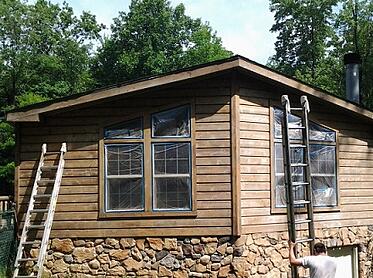How Important Is Exterior Painting Surface Prep?
Jeremy Holderness You could spend $80/gallon on the best lifetime-warranty paint on the market and apply six coats, but if you're not spending the time to do your surface preparation correctly it would all be for naught. Without a doubt, the amount of prep you do will determine the longevity of your exterior painting job.
You could spend $80/gallon on the best lifetime-warranty paint on the market and apply six coats, but if you're not spending the time to do your surface preparation correctly it would all be for naught. Without a doubt, the amount of prep you do will determine the longevity of your exterior painting job.
When I used to work for one of the largest coatings manufacturers, part of my job description was resolving paint failure complaints. And I can tell you from experience, the overwhelming majority of paint failures are the direct result of inadequate surface prep. Period.
Some people skimp on prep work because it's hard, time-consuming work; some because they don't understand just how important it really is; and some because they don't know how to go about it. While we can't do much about the difficulty of the job, this week's article will go through each step in the process so at least you'll have the know-how to get it done right.
1.) Clean
Houses get dirty from dust and other environmental contaminants. If you leave these contaminants on the surface when you paint, your paint will be sticking to the dirt and not to the surface that you want it to stick to.
When I was investigating paint failures it was easy to tell when lack of pre-paint cleaning was the cause of a paint failure. I could just look at the back of a paint chip that was peeling off of the house and if I could see dirt then I knew that it hadn't been cleaned properly.
I can also tell you that if you begin the warranty claim process with the store where you purchased the paint, they will likely send a representative out to your home and go through the same steps to determine the cause of the failure. If they find contaminated paint chips they will most-likely refuse to honor the terms of the 20-year, 30-year, or lifetime warranty on the label of the can that you paid so much extra money for.
So do yourself a huge favor and do a thorough pre-paint cleaning of all of the areas to be painted. You will get far more life out of a mid-grade paint that's been applied over a clean, well-prepared surface than you will out of a top shelf product that's been put on a dirty house.
The only question really is how to do your pre-paint cleaning. There are a couple of choices when it comes to cleaning -- high pressure washing or hand scrubbing. There are benefits and drawbacks to both methods, so check out our blog article 'Pre-Paint Cleaning Methods: Pressure Washing Vs. Hand Scrubbing' for specifics on how to go about doing both of them.
2.) Let It Dry
This may sound a bit ridiculous but it should be said that paint, primer, and caulking do not stick well to damp surfaces. Pre-paint cleaning will make your siding wet, and if you've used a pressure washer it can stay wet for days.
Always be on the safe side and allow several days for the surface to completely dry-out before you proceed to the next step. For those of you in a rush to get the project completed, down-time can be frustrating, but at least this step doesn't require any physical labor on your part.
3.) Scrape
By the time most folks get around to painting their home it's because they're starting to see peeling paint. If that's also true in your case, you'll need to scrape all of the loose coatings until all that's left are sections of well-adhered paint and bare surfaces. Leaving any peeling or curled edges will definitely result in paint failure.
There are lots of different types of scrapers on the market. I personally prefer a long-handled pull scraper. They make quicker work of removing peeling paint, and have replaceable blades for when it becomes dull. Just be careful with them because they can gouge into the siding if you get aggressive with your work.
It's also helpful to have a painter's multi-tool so you can get into tight areas and corners easier.
4.) Repair Damage & Set Nail Heads
If you have any rotted or damaged sections of siding or trim then you'll want to repair them at this stage of the game. Check out this recent blog post on Exterior Rotted Wood Repair Tips for more information on how to do it.
Be sure to set any protruding nail heads just slightly below the surface as well, using a hammer or the butt end of your painter's multi-tool.
5.) Sand
The next step is to sand all of the surfaces smooth. This includes sanding down any rough exposed wood as well as feather-sanding the edge of the remaining paint that's still on the siding. This will reduce the appearance of the transition from the bare surface to the existing coating when you paint over top of it all.
Do yourself a favor and either purchase or rent an electric sander for this job. A belt sander will work, but can be a bit aggressive at times. The best choice would probably be a random orbit sander. Pick up some medium and fine grit sandpaper. If the surface is rough you'll need to start with the medium grit and finish with the fine grit, if it's not then you can skip straight to the fine.
After you've sanded everything down you need to remove the dust from the surface so the primer and paint will stick. You can wipe it all down with a rags, blow it off with an air compressor, or give it a rinse with a garden hose or the pressure washer. If you do use water, make sure you wait until it's completely dry before proceeding.
6.) Prime
If you didn't have any peeling paint you should be able to skip this step and go on to the next. If you did then you'll at least need to do some spot-priming of the bare areas, because paint doesn't always stick well to bare substrates. Make sure to use a good quality primer that's suitable to being used on the surface you're applying it to.
There are several multiple-use primers on the market that will work for most applications. One of my personal favorites is Bullseye 1-2-3 made by Zinsser.
Rarely is there a need for complete stripping of the old coating prior to painting. However, there are some situations when the old paint will not stop peeling. Fortunately there is a line of primers that are on the market now that can even solve this problem and save you from a paint stripping nightmare.
Also check out our blog article entitle Primer Before Paint: When Is It Necessary & When Is It A Waste? for more information on the topic of priming.
7.) Caulk
Caulking doesn't just make your paint job look pretty it also keeps water from getting into the structure and causing damage. Make sure all siding butt joints, as well as gaps where siding meets trim are sealed to prevent water infiltration. But don't get overzealous and caulk the horizontal laps on clapboard siding as this would prevent it from breathing.
Before applying new caulking be sure to dig out any existing caulking from the joints that has either cracked or pulled away from the joint. With a little instruction and practice you can apply caulking like a professional painter and your project will turn out looking great.
FYI, there is a huge selection of caulking to choose from along with a wide range of prices. There is absolutely a big difference in performance in caulking so buy the best that you can afford to use.
Once you've completed these steps, you're ready for paint. There are some important things to consider when choosing an exterior paint so do your research before going shopping. If you're going to put that much time and effort into prep work you want to make sure that you're picking a coating that will hold-up well for you for several years.
If you're located in the Greater Pittsburgh or Western Pennsylvania areas and would like some assistance with your exterior painting project please give us a call at 724-898-2446, visit our 'Contact Us' page, or click on the button below to have us contact you.








